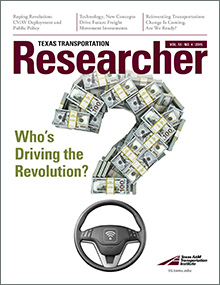Researchers at the Texas A&M Transportation Institute (TTI) recently formulated scenarios for how CV/AV technologies might be deployed. Using the scenarios as context, the research team interviewed state and local transportation agency personnel and then created flexible strategies to prepare for potential issues arising from implementation.

As Senior Research Scientist Johanna Zmud explains, “The goal was to identify strategies that state and local agencies can adopt now to prepare for the future, regardless of which scenario, or mixture of scenarios, comes to pass.”
The study examines two scenarios — the Revolutionary Path and the Evolutionary Path. In the Revolutionary Path, the private sector pushes technologies to market through aggressive research-and-development investments. Progress is not halted by regulatory or policy issues, and self-driving vehicles are on the road in significant numbers by 2025. In the Evolutionary Path, the private sector makes stepwise improvements in advanced driver-assistance systems. Policy, regulatory and technical issues slow testing and deployment. Significant numbers of self-driving vehicles don’t appear on roadways until 2050.
Zmud and her team found the following from talking with public-sector stakeholders:
- By small margins, interviewees from state departments of transportation thought that the Evolutionary Path scenario would be most likely, and it was also the most preferred path because it’s assumed to be less disruptive for agencies.
- Most local and regional transportation agencies interviewed considered the Revolutionary Path scenario most likely and most preferred. The rationale was that if the private sector pushes this quickly, it would bring financial resources with it to support deployment at the local level.
- A few thought that AVs would follow a Revolutionary Path, while CVs would follow an Evolutionary Path.
“Research of this nature is critical to the future of our transportation system because it helps agencies anticipate some of the changes coming down the pike,” says Ginger Goodin, director of TTI’s Transportation Policy Research Center. “Using predictive scenarios, we can better prepare for the impact to our system.”
Suggested strategies from the study to prepare for the future of CV/AV deployment include:
- reviewing current legislation and policies that could impact the implementation of CV/AV technologies,
- designating a specific individual within an organization to be responsible for CV/AVs,
- reaching out to state and local policy makers to familiarize and educate them about CV/AVs,
- participating in the national discussion on CV/AVs, and
- establishing a working relationship with resources in the state or region with useful expertise (e.g., universities, university transportation centers and national laboratories).
“The beauty of scenarios like these is that they give us a range of possibilities,” says Zmud. “The actual future of transportation will unfold somewhere between them. Effective planning and policies are robust and can meet the needs of system users regardless of which scenario comes to fruition.”
